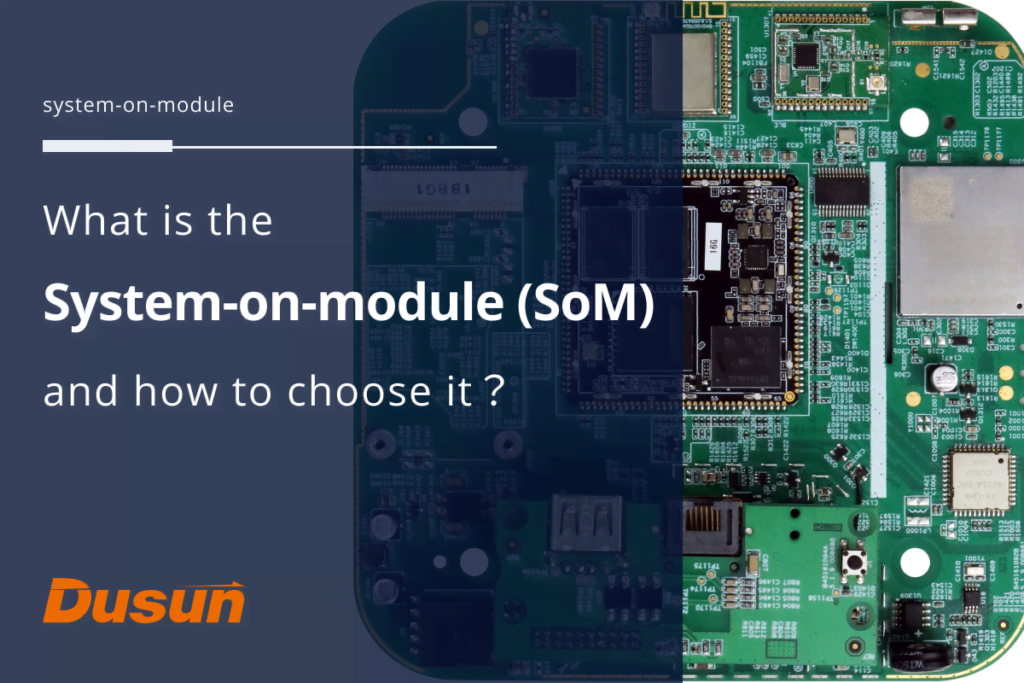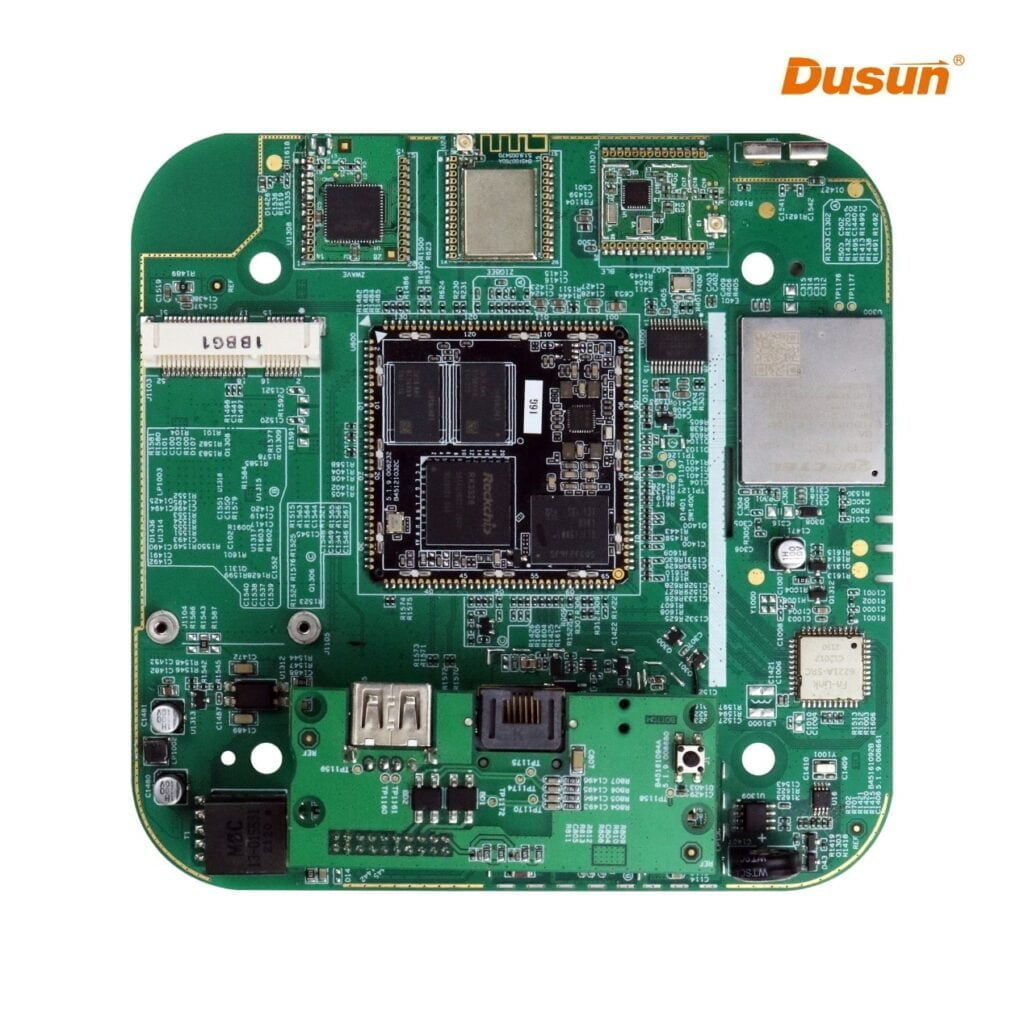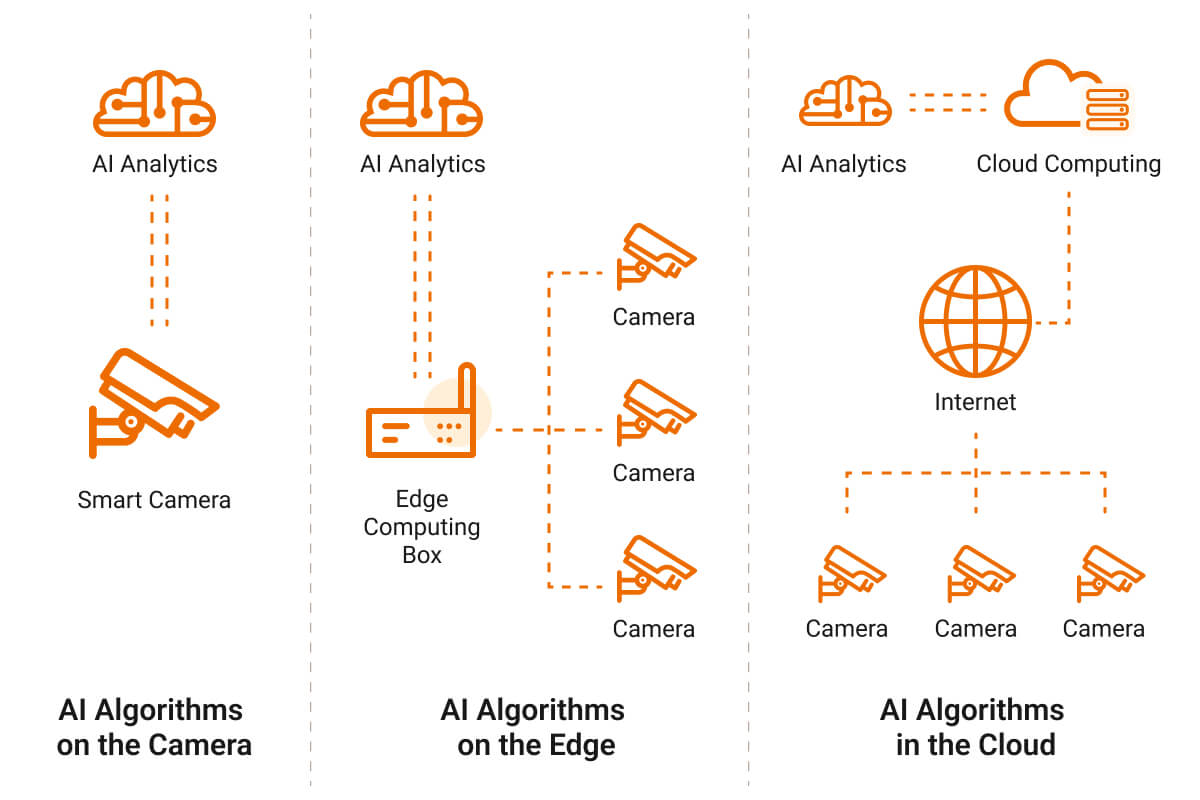Save time, effort, and risk with DusunIoT System on Modules based on various powerful SoC in a small form factor, complete with a ready-to-run Linux-based real-time OS, validated drivers, and productive development.
What is SoM (System-on-Module)?
A System On Module (SoM) is a single physical embedded module integrated into a system function that contains core components including processor cores, communication interfaces, and memory blocks, which may be plugged into a carrier board for the embedded system. It refers to a computer or system bundled into a single module. By simply picking an alternative SoM module from the same pin-compatibility family, the soM-based design allows more scalability.
The SoM can be replaced or improved without replacing the carrier board. SoM offers a plug-and-play benefit. The SoM and carrier board supply the entire system; they typically incorporate the display, connection, GPIO, and other subsystems in a single computer module.
System on Module Diagram Example:


What’s the difference between system on module and carrier board
The System on Module (SoM) and the carrier board together form a complete solution for embedded systems. The SoM handles core computing and processing functions, while the carrier board provides the necessary interfaces, power, and peripherals. This modular design allows developers to flexibly apply the SoM across different projects while customizing the mainboard to meet specific application needs. This combination not only accelerates development and time-to-market but also simplifies the design and upgrade process, offering high scalability and future-proofing for the system.
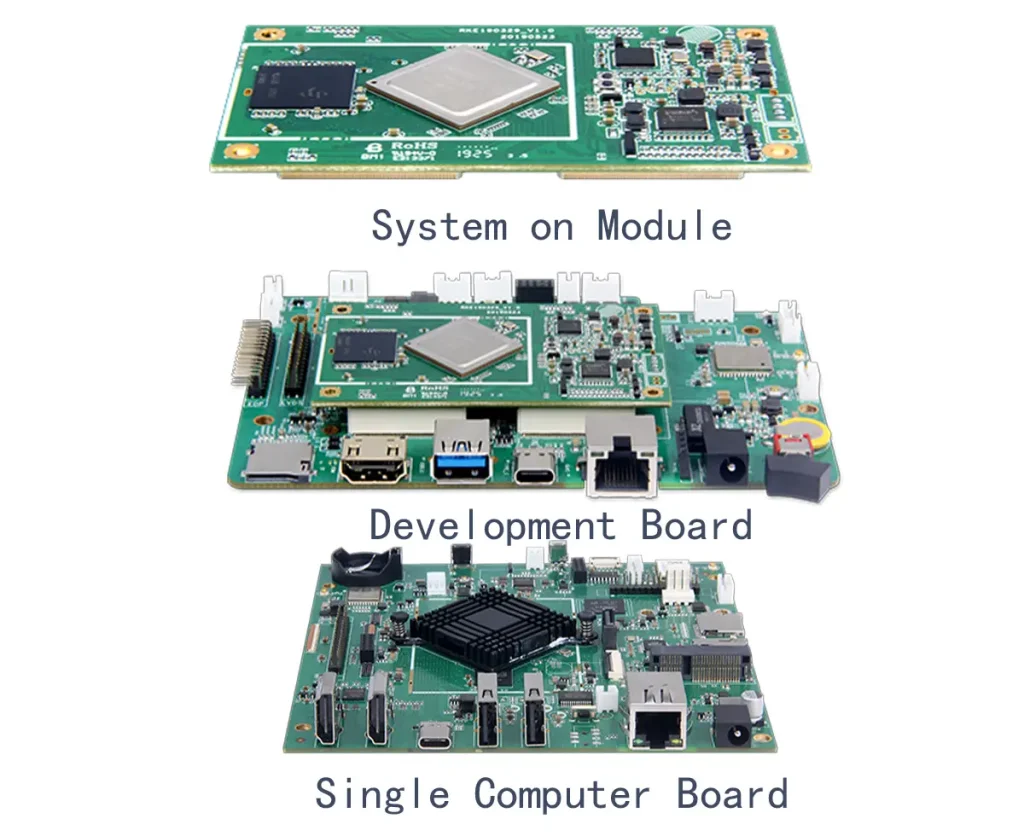
- System on Module (SoM): A SoM is a compact, pre-packaged module that integrates a processor, memory, and essential system functions into one single unit. It is designed to handle the core processing needs of an embedded system with minimal engineering effort. The SoM serves as a building block that developers can use and reuse across different projects, providing a standardized framework for complex designs.
- Carrier Board: The carrier board, provides the necessary interfaces, connectors, and peripherals that allow the SoM to communicate with the external environment. It is designed to accommodate the SoM and provide power distribution, I/O connectivity, and any additional features the specific application requires.
Why Choose System on Modules?
SOM enables developers to achieve design breakthroughs that reduce not only time to market but also costs. Developing an embedded system can be a time-consuming process that necessitates the design and fabrication of custom circuit boards. SOM reduces the number of steps required to complete a procedure. Simply select a SOM that meets your needs and integrate it into the end system, and you’re ready to go.
The modular design not only enables high-volume deployments but also simplifies product lifecycle management and lowers bill of materials (BOM) costs. SOM is worth investigating whether you are interested in software, hardware, or even AI development.
- Faster Time-to-Market: SoMs can significantly reduce development time, allowing products to reach the market quicker. This can provide a crucial advantage in highly competitive industries.
- Reduced Development Risk: By using pre-tested and verified modules, the risk of encountering design flaws and unexpected issues is minimized compared to designing complex systems from scratch.
- Cost Reduction: SoMs can lower overall development costs by simplifying lifecycle management and reducing the bill of materials costs.
- Scalability and Flexibility: SoMs offer scalability and flexibility, permitting developers to adjust and upgrade designs according to needs. The modular design allows for easy integration of new technologies during the development process.
- Simplified Hardware and Software Development: SoMs provide a friendly design environment for both hardware and software developers, avoiding the challenge of building complex PCBs from scratch and allowing them to focus on product-specific functions.
- Easy Integration of Advanced Technologies: Developers can easily integrate AI models and other advanced technologies on SoMs to meet new application demands.
- Reduced Complexity: By integrating multiple system functions, SoMs reduce design complexity, allowing developers to deploy multiple applications using a single carrier board.
These advantages make SoMs widely used across various industries, including IoT, industrial automation, medical devices, and edge computing, among others.
Where can SoM be applied?
IoT Gateway
When large-scale IoT gateway products must be listed as soon as possible, it is recommended to use SoM, depending on the project’s progress. Engineers can reduce time-to-market by starting projects with the most potent SoM modules and then adapting or expanding the SoM based on end-product requirements.
Dusun IoT’s Smart Gateway is built on a diverse range of System on Modules (SoMs) and System on Chips (SoCs) from various vendors, such as Rockchip, NXP, and Nordic. This provides IoT Gateway development with a versatile and convenient platform for creating and maintaining products across multiple industries and applications.
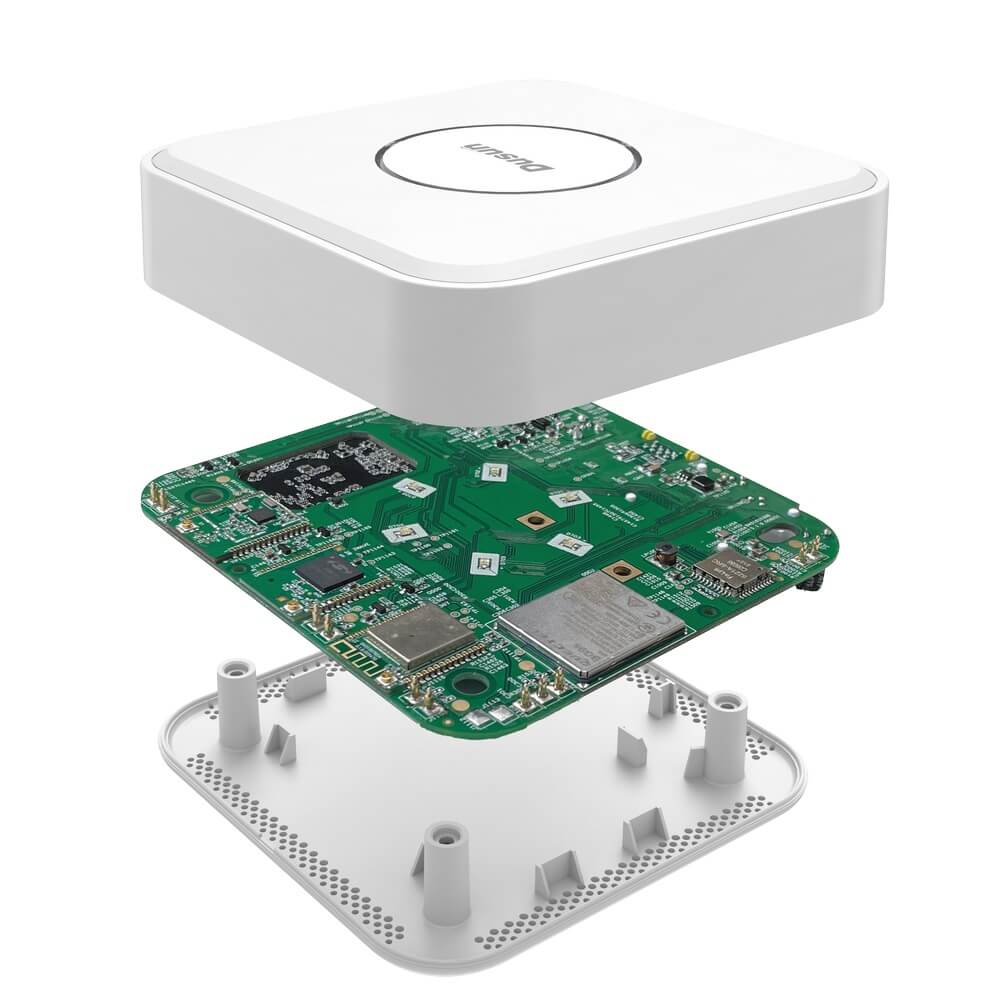
Security Camera
The cutting-edge security camera system fully utilizes the advantages of video analysis, and SOM has contributed. Video analytics-enabled security cameras use machine learning to classify and understand the transactions they see, providing an accurate stream of data in real-time. This would not be possible without edge computing and without cameras and other devices that analyze information on-site.
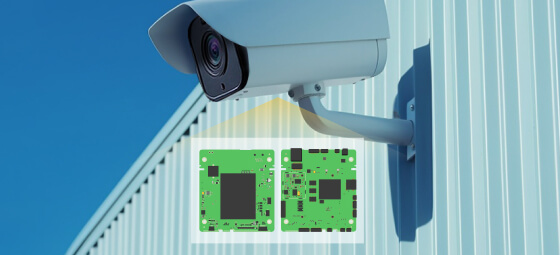
Dusun IoT leverages DSOM-040R Rockchip RK3588 SoM, to create a cutting-edge Single Board Computer (SBC) specifically designed for AI camera development. This high-performance SoC boasts an octa-core processor, featuring a combination of four high-performance Cortex-A76 cores and four energy-efficient Cortex-A55 cores, providing exceptional processing power for real-time analysis and handling of high-resolution video streams,which is a critical aspect for applications demanding high frame rates and video processing capabilities, such as smart security system and smart traffic management.
Machine Vision
The modern economy relies on machine vision for everything from inventory inspection to signature recognition to defect detection. Machine vision requires embedded systems that can both analyze data in the field and provide configurable sensor capabilities. SOM helps developers leverage machine vision at scale while keeping costs low.

NXP’s i.MX 8M Plus System on Module (SoM) is particularly well-suited for machine learning applications due to its integrated features and robust capabilities. The i.MX 8M Plus includes a powerful Neural Processing Unit (NPU) capable of delivering up to 2.3 TOPS, which significantly enhances machine learning inference processes by providing dedicated acceleration, surpassing the capabilities of standard CPU cores. This enables efficient handling of complex neural networks and real-time data processing.
Furthermore, the i.MX 8M Plus SoM features a multi-core architecture, including Arm Cortex-A53 and Cortex-M7 cores, alongside advanced multimedia processing capabilities such as dual-camera Image Signal Processors (ISPs). These features are crucial for executing sophisticated image and video analysis tasks, essential in many machine learning applications. This combination of high-performance processing, efficient power consumption, and robust industrial-grade reliability makes the i.MX 8M Plus an excellent choice for deploying machine learning at the edge, supporting a wide range of IoT and industry applications.
Smart City
Smart cities use ubiquitous sensors to collect data to provide decision makers with the in-depth information they need to keep communities functional and alive. SOM primarily powers these sensors, helping city officials keep track of everything from utilities to traffic in real-time without missing a single nuance.
AGV/AMR Rbots
Using System on Modules (SoMs) in AGVs and AMRs offers several key advantages vital for their operation. SoMs provide compact yet powerful computing, integrating essential computer components into a small form factor, allowing these robots to fit significant processing power into limited spaces. They also offer flexibility and scalability, enabling easy upgrades or replacements to enhance capabilities without redesigning the entire system, which is crucial for adapting to new technological advancements and application requirements.
Additionally, SoMs reduce development time and costs by eliminating the need for custom circuit board design, facilitating faster market entry and cost efficiency. They enhance edge computing capabilities, allowing real-time data processing for critical tasks such as navigation and obstacle detection, ensuring efficient autonomous operation. Moreover, SoMs’ support for AI and machine vision is crucial for tasks like route optimization and real-time obstacle avoidance, significantly enhancing the functionality and effectiveness of AGVs and AMRs in dynamic environments.
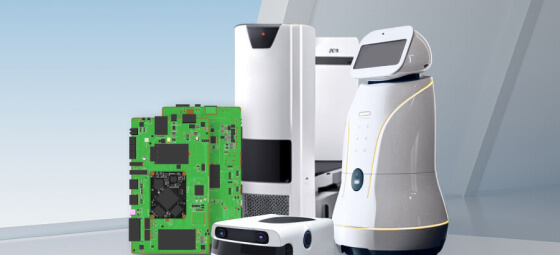
The RK3588J SBC, developed by Dusun IoT and powered by DSOM-040R Rockchip RK3588 SoM, is specifically designed for autonomous mobile robots. This board offers exceptional computing power, multiple interfaces, and industrial-grade quality. Dusun IoT provides a complete SDK and BSP for AMR and AGV applications, allowing autonomous mobile robot companies to focus solely on application development without needing to port low-level drivers.
What factors need to be considered when choosing the right SoM?
CPU architectures
ARM SoM and MIPS SoM are both types of System on Module (SoM) that utilize different CPU architectures – ARM and MIPS, respectively. They are used in various applications due to their distinct features and benefits. Here’s a look at some typical aspects and applications of each:
Typical ARM SoM:
- Features: ARM SoMs generally feature ARM Cortex processors, which could range from low-power Cortex-M series for microcontroller applications to high-performance Cortex-A series for more demanding tasks. They often include built-in memory (RAM and Flash), connectivity options (such as Wi-Fi and Bluetooth), and multiple I/O interfaces.
- Applications: Due to their power efficiency and performance, ARM SoMs are widely used in mobile devices, consumer electronics, industrial control systems, automotive applications, and IoT devices. They benefit from a large ecosystem and a broad range of available software and hardware support.
- Example: An ARM SoM might include a Quad-core ARM Cortex-A53 processor, Mali GPU, multiple USB interfaces, and support for various operating systems like Linux or Android.
Typical MIPS SoM:
- Features: MIPS SoMs often feature MIPS32 or MIPS64 processors, known for efficient pipeline and multithreading capabilities, which are advantageous in specific processing tasks. They may also include essential peripherals and interfaces similar to ARM SoMs.
- Applications: MIPS SoMs are commonly used in networking equipment (like routers and gateways), digital consumer electronics, and embedded systems that require robust data-handling capabilities. Their architecture can be beneficial in applications requiring efficient multitasking and high-throughput processing.
- Example: A MIPS SoM might incorporate MIPS64 processor cores, SDRAM, Ethernet connectivity, and several GPIOs designed for telecom equipment or smart home devices.
Both ARM and MIPS SoMs serve distinct market needs and are chosen based on factors such as power requirements, available development resources, target application performance, and ecosystem support. ARM’s wide adoption provides a versatile solution for diverse applications, while MIPS offers strong processing capabilities for specialized fields such as telecommunications and multimedia.
Performance/processing power
It is critical to understand the need for an embedded application’s processing power. A small-scale SOM is usually sufficient for IoT edge devices, as opposed to an AI-based edge device where the application requires sufficient processing power to do the job.
Power consumption
When designing an embedded system, power consumption and heat produced by the system must be considered. One of the most important criteria in embedded designs is power consumption. A system designed to be connected to a power source, such as mains electricity, can usually ignore power consumption constraints, whereas a mobile design (or one connected to an unreliable power source) may be entirely reliant on power management.
Hardware constraints
The number of peripherals and the constraints associated with them is also important considerations when selecting a SOM. Hardware developers must understand which peripherals, such as 4G, GPS, card readers, and so on, will be present on the carrier board before selecting a SOM.
Software compatibility
Because both Intel and ARM are market leaders in the processor market, comparing software availability and toolchains is difficult. ARM-based devices have the advantage of running mobile operating systems such as Android and Linux. Intel-based devices have the advantage of being able to run virtually any operating system that can be run on a standard desktop PC, including Windows and Linux.
OS emphasis
Android/Windows/Linux: Operating systems are critical in the development of smart devices. Building SDKs and supporting multiple hardware variants are heavily reliant on how we manage the BSP (board support package) used to run the system. Available peripheral drivers and module bring-ups are critical factors in selecting the best fit operating system for the embedded system.
Durability
The design team should consider the SoM’s lifetime, as manufacturers typically support a product for a set period of time. Because the product is partially dependent on a specific SoM, SoM must be included in obsolescence management criteria.
Cost
One of the most important factors for embedded design teams is the budget for building the IoT or smart device, as it affects the final cost of the product. It goes without saying that decision-makers should keep the cost of SoM in mind when preparing Bills of Materials (BOM).
AI Trend in SoM and SoM Recommendation with AI Power
The integration of AI capabilities into System on Modules (SoMs) is an emerging trend driven by the increasing demand for intelligent edge devices. These SoMs support advanced machine learning and data processing tasks directly on the device, which is critical for applications requiring real-time decision-making and reduced latency. By incorporating AI into SoMs, devices can perform complex analyses locally without relying heavily on cloud resources, leading to faster processing times and enhanced privacy.
In terms of SoM recommendations with AI power, several options stand out:
- NXP i.MX 8M Plus SoM: This SoM features a built-in Neural Processing Unit (NPU) capable of delivering up to 2.3 TOPS, making it ideal for machine learning inference tasks. It’s well-suited for applications like image recognition, voice processing, and more complex AI workloads in smart devices.
- Rockchip RK3588 SoM: Known for its powerful AI processing capabilities, this SoM includes an NPU that supports a wide range of AI frameworks and is capable of handling intensive machine learning tasks. It’s particularly effective for high-resolution video processing and AI camera applications.
These SoMs facilitate the development of smarter, AI-powered devices across various industries, from smart home products to industrial automation and autonomous systems. They provide the necessary computational power and flexibility to implement sophisticated AI models directly at the edge.
Final Thought on System on Module
In the ever-evolving world of technology, companies frequently face the pressing issue of rapidly developing and deploying efficient embedded systems, a challenge that often overwhelms with its complexity and cost. This issue is particularly prevalent as businesses strive to integrate versatile and powerful IoT solutions while managing limited resources. The stress compounds as market demands and competitive pressures mount, intensifying the need for a viable resolution. Fortunately, Dusun IoT introduces the System on Module (SoM), a flexible and scalable solution designed to simplify the development process, reduce time-to-market, and lower costs. By leveraging SoM, businesses can seamlessly embed high-performance computing modules into their products, ensuring rapid innovation and staying ahead in the competitive landscape.
The embedded system development will move toward SoMs. The examples given above are just a tiny sample of the numerous applications available. Home automation is a top priority for many people, especially during the pandemic, and the majority of these embedded devices are made with SoM.
For effective productization, Dusun IoT offers its own line of SoM modules that come with a full software package that includes device drivers and supports several operating systems. Dusun IoT’s SoM may be tailored to meet the needs of product development and supports the SDKs of many platforms. Our system-level modular services and solutions enable customers to start developing their software before it is manufactured and help with quick marketing.
System on Module FAQs
What are the benefits of System on Module?
Following are several benefits of System on Module:
- Saves time: It takes far less time to build a product based on an SoM than to design a complete system from the start.
- Development cost: A system on module significantly reduces the development cost of developing an embedded system.
- Simplicity: One can use an SoM and spend the rest of the time focusing on the personality of your product and taking advantage of the complexity. Hardware developers can obtain the performance and flexibility of an FPGA with a SOM without having to deal with the challenges of PCB design and integration.
What is the Difference between SoM and SoC?
System on Module (SoM) may come with an onboard SoC (System on Chip) and is one level higher than an SoC, but not fully functional as a single-board computer. The SOM will typically contain peripheral functionality integrated into the microprocessor SOC.
What is the Difference between SBC and SOM?
SBCs provide a ready-to-use embedded development platform for the creation of end products. SBC reduces development costs and technical risks while accelerating time-to-market. However, a System on Module (SoM) is a better option for building embedded products. Its modular design offers better flexibility, allows more scalability, and significantly decrease the development difficulty and time.
This article talks about the differences between Single Board Computer & System on Module, aiming to help your IoT project progress.
How to Design a PCB for a System on Module?
Every system-on-module is designed to connect to another board (typically referred to as the carrier board or main board) via a connector. This connection can be made in three possible ways:
- With mezzanine connectors on the back side of the SOM
- By placing castellated holes on the SOM and soldering directly to the main board
- Using an edge connector with exposed pins lined along the edge of the SOM
SOMs typically need to support a large number of high-speed signals in several interfaces, so the board must be designed using high-speed PCB design best practices. Standard computing and peripheral interfaces like USB and Ethernet are examples of typical interfaces found on an SOM. There may also be MIPI protocols included in SOMs that will interface with a display or camera.
Why use Linux support System on Module?
In the industrial automation, medical device, telecom/datacom, military, and aerospace industries, Linux is a popular open-source operating system. As an alternative to proprietary operating systems, it is the operating system of choice for many CPU (Central Processing Unit) architectures. Systems typically come with a Linux kernel, a Linux file system, and a boot-loader (most frequently Das U-Boot). The benefits of using embedded Linux system on module include licensing cost advantages, flexibility of source code access, general familiarity, a stable kernel, and availability of a variety of applications and tools. Learn more about Linux IoT here.









